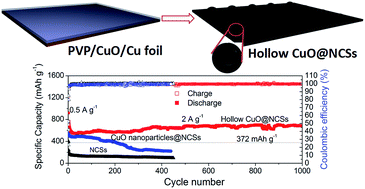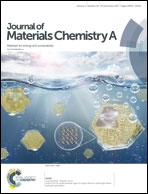Controllable synthesis of hollow copper oxide encapsulated into N-doped carbon nanosheets as high-stability anodes for lithium-ion batteries†
Abstract
Copper oxide is one of the promising anode materials for lithium-ion batteries (LIBs) due to its high energy density. However, it suffers from fast capacity fading and poor cycling stability, arising from the low electrical conductivity and the large volume expansion. Herein, we report a chemical vapor and solid deposition strategy for the synthesis of hollow copper nanoparticles supported by N-doped carbon nanosheets (Cu@NCSs) on Cu foil, adopting a polymer as the carbon source. After successive oxidation treatment, the construction of hollow copper oxide encapsulated into N-doped carbon nanosheets (CuO@NCSs) is achieved. The resulting products are used as anodes in LIBs, displaying a capacity of 688 mA h g−1 over 1000 cycles at 2 A g−1 and a capacity of 400 mA h g−1 at 4 A g−1. Such superior performance is attributed to the well-designed hollow CuO@NCS composites, which not only improve the electrical conductivity of electrode materials, but also allow easy penetration of electrolyte and mitigation of the volume expansion.



 Please wait while we load your content...
Please wait while we load your content...